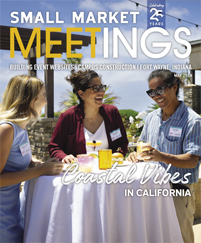During the recession, many meeting planners, even at high-end financial firms, turned to lesser-known destinations close to home to give their groups something new without breaking the bank. As this trend on the meeting side and the rise in staycations on the leisure side collided with locavore food movements and a growing interest in experiential travel, having a meeting somewhere near but new has become all the rage, thanks to cultural opportunities available in these destinations.
Here are five smaller cities across the country where meeting groups can immerse themselves in local culture.
Paducah, Kentucky
In 2013, Paducah, Kentucky, became the third city in the United States to be recognized as a UNESCO Creative City for its incredible legacy of fiber artisanship. As only the seventh city in the world to be chosen for its crafts and folk art, Paducah, the home of the National Quilt Museum and one of the largest annual quilting shows in the world, was a natural choice. But the city has even more to offer groups.
“The Lower Town Arts District was a pioneer in its day in terms of urban renewal, using artists from all over the country who essentially cut and pasted themselves into lower-cost studios here,” said Fowler Black, sales director for the Paducah Convention and Visitors Bureau.
The CVB has created five signature experiences for groups to dive into the artistic, geographic and cultural heritage of the city. Groups of up to 50 can work with the Yeiser Art Center to organize a walk of the floodwall murals followed by a hands-on painting experience, or they can take a VIP tour of the National Quilt Museum and create their own fusion fiber arts. Smaller groups can also do a two-hour workshop to learn to make custom quilt blocks.
Albuquerque, New Mexico
In Albuquerque, New Mexico, there are so many local cultural activities competing for groups’ attention, it can be hard to choose. The Native American culture mixes with the Spanish colonial, which flows into the Mexican, which bolsters the Western cowboys.
Albuquerque has the honor of being home to two world-class cultural facilities: the Indian Pueblo Cultural Center, which represents the 19 Pueblo Nations in New Mexico, and the National Hispanic Cultural Center. Both include museums as well as meeting rooms, allowing groups to break up their event with museum tours or experiential team building, such as the Hispanic Cultural Center’s immersive genealogy activity. That center also has three theaters, with room for up to 700 guests in the largest.
“One of the things we tell our planners is that if they don’t have the budget to leave the hotel or convention site, or if they have a packed schedule but still want attendees to have the experience of the city, they can have solo guitarists or trios, flamenco dancers, or Native American dancers and flautists at their venue,” said Cecilia Padilla-Quillen, director of convention services for the Albuquerque Convention and Visitors Bureau.
Shreveport, Louisiana
Thanks to its location on the Red River right near where Texas and Arkansas meet Louisiana, Shreveport, Louisiana, has long been a bustling trade town. Oil money throughout much of the 1900s kept the city flush with opulent mansions and a rich culture of music clubs, and the dawn of riverboat casinos just before the turn of the millennium ensured that energy carried through to today.
Shreveport’s history can come alive for your group as the CVB organizes walking tours through town in which meeting groups can run into Bonnie and Clyde, Hank Williams, Huddie Ledbetter and Elvis Presley on their way to dinner.
“When we have a group in town, everybody goes the extra mile,” said David Bradley, vice president of convention and tourism sales for the Shreveport-Bossier Convention and Tourist Bureau. “Business owners say, ‘Let me know if you need me to volunteer.’ The local culture is overwhelming. Everybody gets treated the same here, and I really like that.”
From a retreat in the green room at the Silver Star Smokehouse, to a private tour and concert in the Shreveport Municipal Auditorium where Elvis had his first performance, to a meeting in a community general store dating back to 1898, Shreveport’s “come on in” culture opens doors to venues that feel intimate, no matter the size.











